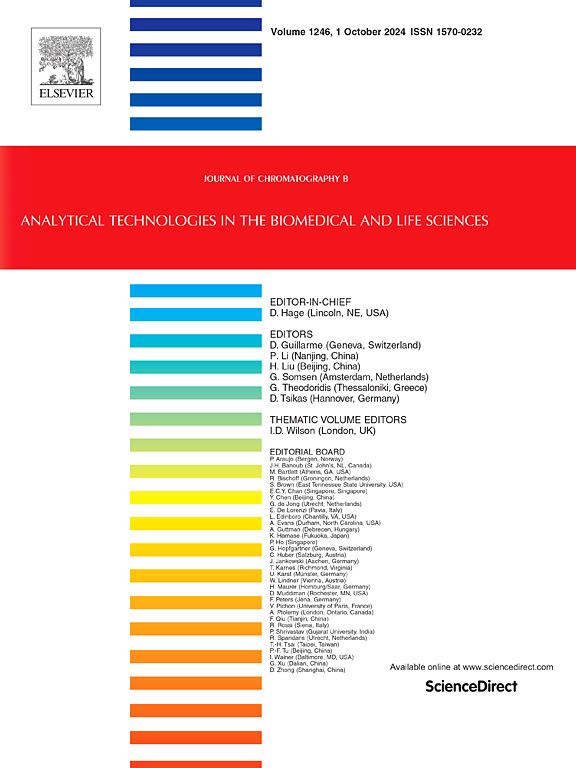利用分子对接和亲和超滤技术筛选人参中活化CYP19A1酶启动子的化合物治疗绝经后骨质疏松症
IF 2.8
3区 医学
Q2 BIOCHEMICAL RESEARCH METHODS
引用次数: 0
摘要
绝经后骨质疏松症的主要病因是雌激素缺乏。芳香化酶(CYP19A1)是雄激素转化为雌激素的关键限速酶。本研究以人参为研究对象。研究发现,50%乙醇人参提取物对CYP19A1酶活性的测定最有效。随后使用UHPLC-QE Orbitrap-MS结合质谱分子网络技术对该提取物进行分析。为了鉴定对绝经后骨质疏松有效的活性成分,采用了酶超滤亲和、分子对接和动力学模拟技术。结合能和亲和率交叉分析结果显示,人参皂苷Re和人参皂苷Rf具有最高的绝对结合能和亲和值,是最有效的活性成分。通过体外验证ALP、OPG、凋亡和qPCR等机制,证实了这些活性成分的抗ppu作用。本研究提供了一种高效、快速的方法来筛选天然产物,以确定治疗绝经后骨质疏松症的有效成分。本文章由计算机程序翻译,如有差异,请以英文原文为准。
Screening of compounds in ginseng that activate CYP19A1 enzyme promoters for the treatment of postmenopausal osteoporosis using molecular docking and affinity ultrafiltration technology
The primary etiology of postmenopausal osteoporosis is estrogen deficiency. The enzyme aromatase (CYP19A1) serves as the key rate-limiting enzyme in the conversion of androgens to estrogens. In this study, ginseng was selected as the subject of investigation. The study identified that the 50 % ethanol extract of ginseng exhibited the most potent activity in the determination of CYP19A1 enzyme activity. This extract was subsequently analyzed using UHPLC-QE Orbitrap-MS in conjunction with mass spectrometry molecular network technology. To identify the active components effective against postmenopausal osteoporosis, enzyme ultrafiltration affinity, molecular docking, and kinetic simulation techniques were employed. Cross-analysis of binding energy and affinity rate results revealed that ginsenoside Re and ginsenoside Rf possessed the highest absolute binding energy and affinity values, establishing them as the most effective active components. The mechanisms involving ALP, OPG, apoptosis, and qPCR were validated in vitro to confirm the anti-PMOP effects of these active ingredients. This study offers an efficient and rapid method for screening natural products to identify active components for the treatment of postmenopausal osteoporosis.
求助全文
通过发布文献求助,成功后即可免费获取论文全文。
去求助
来源期刊

Journal of Chromatography B
医学-分析化学
CiteScore
5.60
自引率
3.30%
发文量
306
审稿时长
44 days
期刊介绍:
The Journal of Chromatography B publishes papers on developments in separation science relevant to biology and biomedical research including both fundamental advances and applications. Analytical techniques which may be considered include the various facets of chromatography, electrophoresis and related methods, affinity and immunoaffinity-based methodologies, hyphenated and other multi-dimensional techniques, and microanalytical approaches. The journal also considers articles reporting developments in sample preparation, detection techniques including mass spectrometry, and data handling and analysis.
Developments related to preparative separations for the isolation and purification of components of biological systems may be published, including chromatographic and electrophoretic methods, affinity separations, field flow fractionation and other preparative approaches.
Applications to the analysis of biological systems and samples will be considered when the analytical science contains a significant element of novelty, e.g. a new approach to the separation of a compound, novel combination of analytical techniques, or significantly improved analytical performance.
 求助内容:
求助内容: 应助结果提醒方式:
应助结果提醒方式:


